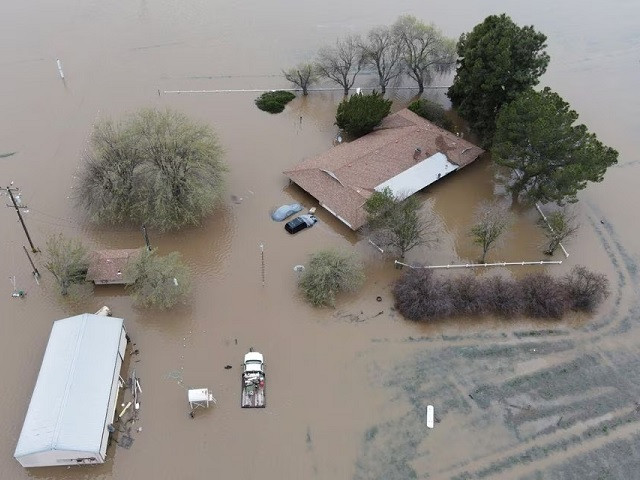Title: California lashed with 12th 'atmospheric river' cloudbursts
Share:
Linkedin
Whatsapp
Facebook
 Description:
Description:
The latest burst of heavy, wind-blown rain and snow churned out of the Pacific into California on Tuesday, triggering scattered floods and mudslides, uprooting trees and leaving thousands of storm-weary residents under evacuation orders.
The newest onslaught, arriving early on the second official day of spring, was concentrated mostly in Southern California, the state's central coast and its agricultural heartland, still sodden from a relentless string of storms that began in late December.
High-wind warnings and advisories were posted for a vast area stretching from the Mexico border through Los Angeles to the San Francisco Bay area. Winter storm warnings were in effect for high mountains, with several feet of snowfall forecast.
The National Weather Service (NWS) also issued flood watches across a region of more than 17 million people, including most of greater Los Angeles and a large swath of western and central Arizona.
Gusty, gale-force conditions posed a bigger hazard around Santa Cruz and the Bay area, with sustained winds of 60 to 70 miles per hour (97 to 113 kilometres per hour) toppling trees and power lines, according to Frank Pereira of the NWS Weather Prediction Center.
There was at least one wind-related fatality: a person killed in a vehicle by a fallen tree in Sonoma County, north of San Francisco, Pereira said.
More than 14,000 people statewide were under orders to seek higher ground because of flooding, with evacuation warnings issued for another 47,000 residents, said Diana Crofts-Pelayo, a spokesperson for the California Office of Emergency Services.
The bulk of evacuation orders, covering some 12,000 people, were in Tulare County, a flood-stricken region in the San Joaquin Valley where high water from recent levee breaches has inundated a number of communities, Crofts-Pelayo said.
Otherwise, flooding on Tuesday was scattered mostly to the south. They included the rescue of a motorist whose vehicle was swept away in a flooded stream and an SUV pulled from a mudslide in San Diego County, Pereira said.
Nearly 250,000 homes and businesses were without electricity statewide, according to utility tracking service PowerOutage.us.
Emergency teams throughout the state patrolled rain-swollen streams, repaired damaged levees and cleared debris from storm drains and culverts to minimize flooding of populated areas.
Crews in San Luis Obispo County were on alert for Lopez Reservoir to reach full capacity for the first time in 25 years and spill over into an adjacent creek that runs to the seaside town of Oceano, bounded by a weakened levee, said Rachel Monte Dion, a county emergency services coordinator.
If the levee is overtopped to the north, instead of the south as designed, it could flood the homes of about 1,500 Oceano residents, she said.
Parade of storms
The mix of high winds, heavy showers and snow was expected to spread across the Southwestern US into the central Great Basin and Rockies by late on Tuesday and persist through Wednesday night, the NWS said.
The storm marked the 12th so-called atmospheric river since December to sweep the US West Coast, formed from an immense airborne current of dense water vapour carried aloft from the ocean and flowing overland in bouts of heavy rain and snow.
A Pacific cyclone swirling around an intense low-pressure system off San Francisco was driving the latest system, drawing up vast quantities of moisture and channelling it to the coast.
Unlike earlier atmospheric rivers this season, the latest packed a cooler load of moisture, meaning more snow fell in the coastal mountains and Sierra Nevada range.
As much as 3 to 4 feet (1-1.2 meters) were forecast at elevations above 6,000 feet, where some areas remain blanketed in the snow left last month.
Up to 3 inches (7.6 centimetres) of rain were expected in coastal regions and valleys of Southern California, and as much as 6 inches in lower mountains and foothills, the NWS said.
The rapid succession of Pacific storms during the past three months has come as an abrupt reversal of fortunes for a state preoccupied for the past few years by drought and wildfires - a swing in weather extremes that experts say is symptomatic of human-induced climate change.
California's harsh winter has caused widespread property damage and upheaval for thousands of residents, with more than 20 deaths attributed to the storms.
But the glut of precipitation has also replenished sorely depleted reservoirs and the state's mountain snowpack, both providing a critical source for drinking supplies, irrigation, and sustenance for fish and wildlife.
Published Date: 22-Mar-2023
Share:
Linkedin
Whatsapp
Facebook
